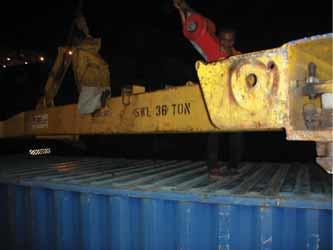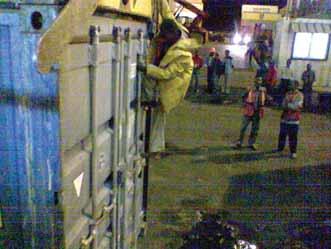200819 Unsafe stevedoring practices

1: Manhandling the spreader: one worker has no shoes and the other is wearing ‘flip-flops’
 2: Stevedore climbing down a container. Note the relatively well-kitted out ‘supervisory’ staff
2: Stevedore climbing down a container. Note the relatively well-kitted out ‘supervisory’ staff
I witnessed very unsafe working practices at a container terminal where my vessel called recently. For every lift, the stevedores clambered on to the roof of the container without a proper ladder, although occasionally they would be hoisted aloft while standing on the forks of a fork lift truck. The dangerously exposed men struggled to position the spreader on the containers and were working without any safety shoes, helmet or working gloves. At least one of them was barefoot. On board another vessel that was finishing loading at the terminal, we witnessed a stevedore climbing down from a height of five containers.
My questions are: when there are so many regulations enforcing safe working practices on board ship, why and how can an international container terminal allow stevedores to work without any safety gear? Don't they have a safety management system? I find it hard to believe that service conditions do not include safety training and free issue of working gear for employees and that the local authorities have permitted these unsafe operations to continue without any sanction.
My concern is that if a stevedore is injured on board, the vessel will be subjected to a very harsh inquiry/investigation and the authorities will likely exonerate the stevedore company of any blame and instead unfairly hold the ship liable for damages.
FEEDBACK - November 2008
As an occupational health and safety (OHS) practitioner currently working in a stevedoring company, I make the following recommendations:
Check in advance of the port call, with the local ship's agent or P&I correspondent, what the governing OHS regulations are in the port and match them against those in the ship's SMS. Be guided by the stricter.
Before cargo operations commence, discuss safety matters and jointly complete and sign ISPS, OHSAS (Occupational Health and Safety Management System) and ship-shore safety checklists with the stevedore representative and hand over a copy of the ship’s risk assessment record, as appropriate.
Demarcate and point out hazardous areas and control measures already taken by vessel. Also show the designated safe locations and state what personal protection equipment (PPE) is required for personnel involved.
Emergency response arrangements in case an accident occurs on board.
Cargo loading / discharge plan, other operations and cargo stowage and securing requirements.
If ship’s cargo gear is going to be used, ensure all maintenance and statutory records are valid and available for inspection.
Confirm qualifications and experience of those ship’s and shore personnel that will be operating cargo equipment, brief them on operation techniques, safety controls and means of communication (signals, portable radios, working language etc.)
Obtain written acknowledgement of the above requirements from the stevedoring company representative.
Require the stevedoring company to submit:
Test certificates, maintenance reports and pre-operation checks of the gear they provide and intend to use, eg fork-lift trucks, cranes, slings and ladders.
Written confirmation that they have carried out a formal risk assessment for the operation and that they will update it with the information you have made available to them.
Written confirmation that they will only engage properly qualified and trained workers, training and those in supervisory roles have sufficient English language skills for the tasks they are going to perform.
Duty schedule with names and contact details of shore personnel.
Besides ensuring loss-prevention, the measures suggested above will help protect the master, vessel and owners against unjustified damage / personal injury claims from stevedores.
